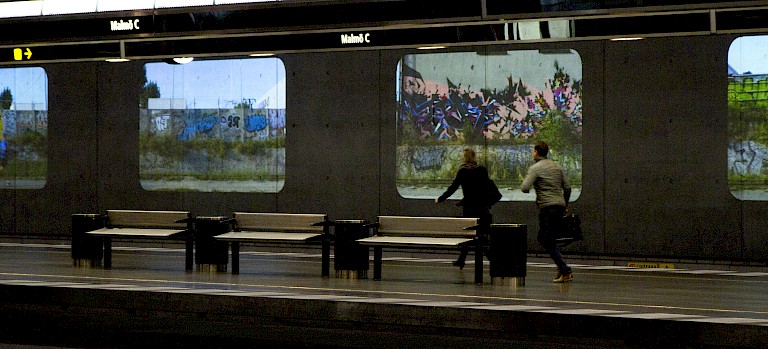



Elsewhere turns the stark concrete walls of Sweden’s underground Malmö Central Station into the windows of a train. Covering both sides of a 180-meter stretch of the station, 46 projected “windows” present 1-12 minute films of passing cityscapes, countrysides, industrial landscapes and city outskirts, filmed internationally during three years of production. Totaling 1,500 sequences and 90 hours of footage, these vignettes are connected to a complex software program and are continuously reordered according to a specially designed grammar. Viewers are therefore met with an ever-changing combination of sequences flowing one after the other and juxtaposed with shifting counterparts on the other side of the station.
Rather than iconic postcard images of major cities, these films feature anonymous spaces often overlooked or passed through. There is a mystery here, and a game, as well as an open-ended starting point for questions. Inspired by late 19th century panoramas, train travel, and nascent cinema, Elsewhere showcases the act of travel itself, particularly relevant for a station serving Copenhagen airport and 87,000 daily commuters. On the one hand, the images unite across space, indicating a “universal present” that unfolds concurrently across continents. But the work also distances—heightening one’s small position within a vast world. The leisurely flow of images reflects the contemporary compression of space through new technology, but this seeming ease is also laid bare for critique—hinting at unseen barriers and the connection between travel and privilege. As the software curates new juxtapositions on either side of the station walls, it cycles through a spectrum of differences and similarities, offering interpretations ranging from personal and philosophical to geopolitical.
Elsewhere is significantly tied to place, but it is also importantly connected to time. Averaging four minutes in length, the filmed sequences unfold for waiting passengers, referencing the passengers’ own travel as well as the station itself—the place between places. As new technology increasingly enables the transformation of all time into “productive” time, the “unproductive” time of waiting paradoxically serves a unique role. It is time set free, when one can do nothing and, in this respect, it potentially provides an opening for contemplation. This is even more potent in Malmö Central Station where a building initiative creates an advertising-free space, including Elsewhere’s footage. Instead of being bombarded by ads, riders are presented with the poetic, evocative, and at times playful images of Elsewhere. Whereas ads might offer closure—an answer to life’s problems—Elsewhere presents an opening, the start of a conversation, an unending inquiry.
As a placemaking project, Elsewhere both enhances and reflects upon its site. Designed and installed as part of the construction of the station, it has been heralded as the “largest permanent video artwork in Europe” and transforms cold concrete into open landscapes. It alludes to varied technological shifts from panoramas and locomotives to the internet and high speed trains, inviting viewers to enjoy, ponder, question, and consider relationships to myriad “elsewheres” historic and current. It positions “the world” not “somewhere else,” but rather simultaneously near and distant, interconnected and present. In doing so, Elsewhere offers a renewed experience of the concept of “place” as both distinct and expansive, an apt installation for a place of transit.
All copyright belongs to Shanghai Academy of Fine Arts, Shanghai University.



